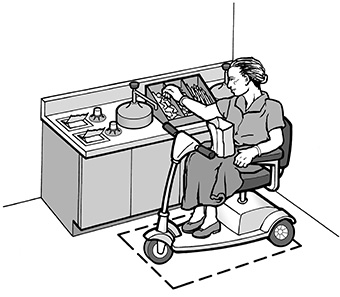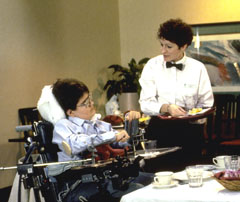Food Service BASICs
In the past, emphasis on complying with the ADA has been about physical access. While being able to enter your restaurant, access services, and use the public restroom are important, equally essential is an awareness of their specific requirements and an attitude of respect for the unique needs of your customers with disabilities. Here are some BASIC tips for your staff to be able to do their best.
ADA also means Attitude Determines Accessibility. To be successful, your awareness has to be equal to your access. The key is increasing the comfort level of managers and employees, teaching them practical skills in how to serve guests with disabilities, knowing the appropriate language, and sending the correct messages. This directly relates to the ADA requirement of “modifying policies, practices, and procedures to avoid discrimination.”
Since the ADA talks about avoiding discrimination, this makes it a civil rights law. Many times businesses think of it as primarily an access law centering on building codes. In reality ADA’s purpose is much larger. The goal is to create equality by improving access to employment, public accommodations, commercial facilities, information technology, and telecommunications services.
To comply with the intent of the ADA, your business IQ needs to understand having a high EQ (Etiquette Quotient) includes being disability friendly. Here are some basic tips to help you improve your EQ:
Be welcoming to your customers with special needs.
Ask what they want or need, never assume.
Speak to the person having the disability, not to any companion.
Instructions come from the customer since they are the experts on their needs.
Check with these customers often, but don’t over do it or be patronizing.
Being disability friendly is not only the prudent thing to do, but is also good business. There are 56 million Americans with disabilities, about 20 percent of the total U. S. population, according to 2006 U. S. Census Bureau statistics. You may not realize this, but persons with disabilities are the largest consumer market in the nation, and they are as diverse as the population at large.
These 56 million are an overlooked consumer market with almost $200 billion annually in disposable income (U. S. Census Bureau, 2002, confirmed by Advertising Age if you don’t trust government statistics). How much of this discretionary income is your restaurant getting? If you don’t have at least 10% of your customers having disabilities, then you need to ask yourself two questions. First, who they are spending their money with and, second, why aren't’t they aren't’t they coming to your place?
Take a closer look at your physical access as your customers with disabilities need to access tables, food service lines, and condiment and beverage bars. In dining areas, remember to arrange tables far enough apart so a person using a wheelchair can maneuver between the tables when customers are sitting at them. Some accessible tables must be provided and must be dispersed throughout the dining area rather than clustered in a single location. In restaurants or bars with only standing tables, some accessible dining tables must be provided.

A woman using a scooter is selecting items from the condiment bar at a casual restaurant. Adequate maneuvering space and items placed within reach make it possible for her to serve herself.
There must be an accessible route to all dining areas, including any raised or sunken dining areas and outdoor dining areas. Where barriers prevent access to a raised, sunken, or outdoor dining area, they must be removed if readily achievable. If it is not readily achievable to construct an accessible route to these areas, then you must make these services available and at the same price in the dining areas that are on an accessible route.
The bottom line is Hospitality 101: If you take care of the customer, business will take care of itself. Persons with disabilities reward their loyalty to businesses that make a wholehearted commitment to help them achieve dignity, equality and independence.


